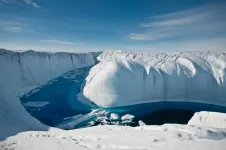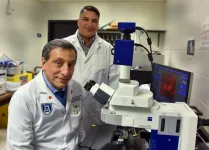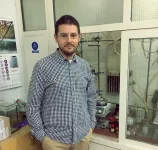INFORMATION:
Global ice loss increases at record rate
2021-01-25
(Press-News.org) The rate at which ice is disappearing across the planet is speeding up, according to new research.
And the findings also reveal that the Earth lost 28 trillion tonnes of ice between 1994 and 2017 - equivalent to a sheet of ice 100 metres thick covering the whole of the UK.
The figures have been published today (Monday, 25 January) by a research team which is the first to carry out a survey of global ice loss using satellite data.
The team, led by the University of Leeds, found that the rate of ice loss from the Earth has increased markedly within the past three decades, from 0.8 trillion tons per year in the 1990s to 1.3 trillion tons per year by 2017.
Ice melt across the globe raises sea levels, increases the risk of flooding to coastal communities, and threatens to wipe out natural habitats which wildlife depend on.
The findings of the research team, which includes the University of Edinburgh, University College London and data science specialists Earthwave, are published in European Geosciences Union's journal The Cryosphere.
The research, funded by UK Natural Environment Research Council, shows that overall, there has been a 65 % increase in the rate of ice loss over the 23-year survey. This has been mainly driven by steep rises in losses from the polar ice sheets in Antarctica and Greenland.
Lead author Dr Thomas Slater, a Research Fellow at Leeds' Centre for Polar Observation and Modelling , said: "Although every region we studied lost ice, losses from the Antarctic and Greenland ice sheets have accelerated the most.
"The ice sheets are now following the worst-case climate warming scenarios set out by the Intergovernmental Panel on Climate Change. Sea-level rise on this scale will have very serious impacts on coastal communities this century."
Dr Slater said the study was the first of its kind to examine all the ice that is disappearing on Earth, using satellite observations .
He added: "Over the past three decades there's been a huge international effort to understand what's happening to individual components in Earth's ice system, revolutionised by satellites which allow us to routinely monitor the vast and inhospitable regions where ice can be found.
"Our study is the first to combine these efforts and look at all the ice that is being lost from the entire planet."
The increase in ice loss has been triggered by warming of the atmosphere and oceans, which have warmed by 0.26°C and 0.12°C per decade since the 1980, respectively. The majority of all ice loss was driven by atmospheric melting (68 %), with the remaining losses (32%) being driven by oceanic melting.
The survey covers 215,000 mountain glaciers spread around the planet, the polar ice sheets in Greenland and Antarctica, the ice shelves floating around Antarctica, and sea ice drifting in the Arctic and Southern Oceans.
Rising atmospheric temperatures have been the main driver of the decline in Arctic sea ice and mountain glaciers across the globe, while rising ocean temperatures have increased the melting of the Antarctic ice sheet. For the Greenland ice sheet and Antarctic ice shelves, ice losses have been triggered by a combination of rising ocean and atmospheric temperatures.
During the survey period, every category lost ice, but the biggest losses were from Arctic Sea ice (7.6 trillion tons) and Antarctic ice shelves (6.5 trillion tons), both of which float on the polar oceans.
Dr Isobel Lawrence, a Research Fellow at Leeds' Centre for Polar Observation and Modelling, said: "Sea ice loss doesn't contribute directly to sea level rise but it does have an indirect influence. One of the key roles of Arctic sea ice is to reflect solar radiation back into space which helps keep the Arctic cool.
"As the sea ice shrinks, more solar energy is being absorbed by the oceans and atmosphere, causing the Arctic to warm faster than anywhere else on the planet.
"Not only is this speeding up sea ice melt, it's also exacerbating the melting of glaciers and ice sheets which causes sea levels to rise."
Half of all losses were from ice on land - including 6.1 trillion tons from mountain glaciers, 3.8 trillion tons from the Greenland ice sheet, and 2.5 trillion tons from the Antarctic ice sheet. These losses have raised global sea levels by 35 millimetres.
It is estimated that for every centimetre of sea level rise, approximately a million people are in danger of being displaced from low-lying homelands.
Despite storing only 1 % of the Earth's total ice volume, glaciers have contributed to almost a quarter of the global ice losses over the study period, with all glacier regions around the world losing ice.
Report co-author and PhD researcher Inès Otosaka, also from Leeds' Centre for Polar Observation and Modelling, said: "As well as contributing to global mean sea level rise, mountain glaciers are also critical as a freshwater resource for local communities.
"The retreat of glaciers around the world is therefore of crucial importance at both local and global scales."
Just over half (58 %) of the ice loss was from the northern hemisphere, and the remainder (42 %) was from the southern hemisphere.
ELSE PRESS RELEASES FROM THIS DATE:
Childhood cancer survivors are not more likely to terminate their pregnancies
2021-01-25
Female childhood cancer survivors face a lower likelihood of becoming pregnant than women in the general population, but once pregnant, they are not more likely to undergo an abortion. The findings come from a new study published early online in CANCER, a peer-reviewed journal of the American Cancer Society.
Cancer survivors might be reluctant to start a family due to concerns for their children's health as well as the potential recurrence of their own cancer. This could lead to a greater likelihood of induced abortions in female survivors who become pregnant.
To examine whether pregnancies of childhood cancer survivors are more likely to end with ...
Fine tuning first-responder immune cells may reduce TBI damage
2021-01-25
AUGUSTA, Ga. (January 25, 2021) - Immediately after a traumatic brain injury and as long as one year later, there are increased levels of immune cells called ILCs in the brain promoting inflammation, which can worsen brain damage, scientists report.
They also report for the first time that the cell energy sensor AMPK is a brake that can stop what becomes a chronic state of destructive inflammation driven by these ILCs, or innate lymphoid cells.
"We think ILCs are kind of a master regulator of all that inflammation happening within the brain," says Dr. Krishnan Dhandapani, neuroscientist in the Department of Neurosurgery at the Medical College of Georgia at Augusta University. "It's like the ...
Efficient solid-state depolymerization of waste PET
2021-01-25
These results were published in the prestigious journal ChemSusChem and thanks to the remarkable reviews, the paper was ranked among the top five percent publications in the field, thus earning a Very Important Paper (VIP) status. Furthermore, the editorial board featured this study on its cover.
Plastic pollution has become one of the most complex environmental issues, especially in the context of increasing production and demand for plastic materials. While innovations in polymer chemistry have radically changed our lives in the mid-20th century, the outstanding properties of plastics such as durability, chemical stability, strength and many other pose a serious problem ...
Women influenced coevolution of dogs and humans
2021-01-25
PULLMAN, Wash. - Man's best friend might actually belong to a woman.
In a cross-cultural analysis, Washington State University researchers found several factors may have played a role in building the mutually beneficial relationship between humans and dogs, including temperature, hunting and surprisingly - gender.
"We found that dogs' relationships with women might have had a greater impact on the dog-human bond than relationships with men," said Jaime Chambers, a WSU anthropology Ph.D. student and first author on the paper published in the Journal of Ethnobiology. "Humans were more likely to regard dogs as a type of person if the dogs had a special ...
Doctoral student leads paleoclimate study of precipitation and sea ice in Arctic Alaska
2021-01-25
Arctic sea ice is rapidly diminishing due to global warming, and scientists have found that sea ice dynamics have a big impact on circulation and precipitation patterns in Arctic Alaska, which lies at a climatological crossroads between the Arctic and North Pacific Oceans. Recent studies--most of which focus on current trends in the region and on what will happen in the future--have shown that circulation patterns in the Arctic and North Pacific Oceans influence one another.
Doctoral candidate Ellie Broadman of Northern Arizona University's School of Earth and Sustainability wanted to learn about this relationship on a longer timescale, so she developed and led a ...
Continued strict control measures needed to reduce new COVID-19 strains
2021-01-25
A group of scientists is calling on governments to consider the continued use of strict control measures as the only way to reduce the evolution and spread of new COVID-19 variants.
The experts in evolution, virology, infectious disease and genomics - at the University of East Anglia (UEA), Earlham Institute and University of Minnesota - warn that while governments are negotiating a "precarious balance" between saving the economy and preventing COVID-19 fatalities, stronger action now is the best way to mitigate against more serious outcomes from such virulent strains later.
While COVID-19 vaccine deployment is now underway, a threat to vaccine effectiveness comes from other emerging strains, both existing - such as the UK, South Africa and Brazil variants ...
The Lancet: World failing to address health needs of 630 million women and children affected by armed conflict
2021-01-25
New estimates reveal extent of the health burden of armed conflict--affecting at least 630 million women and children worldwide in 2017, and contributing to more than 10 million deaths among children under 5 years of age over 20 years.
Changing nature of war is a growing threat to humanitarian access and the provision of essential health services for women and children, but responses in countries like Syria, Pakistan, and Colombia may provide context-specific innovative ways forward.
Armed conflicts are becoming increasingly complex and protracted and a growing threat to humanitarian access and the delivery of essential health services, affecting at least 630 million women and ...
Dramatic changes to radiotherapy treatments due to COVID-19
2021-01-23
Dramatic changes were seen in the delivery of radiotherapy treatments for cancer during the first wave of the coronavirus pandemic in England.
Much shorter radiotherapy courses were delivered, treatments were delayed where it was safe to do so and some increases were seen in order to compensate for reduced surgical capacity.
Experts believe the changes reflect an impressive adaption of services by the NHS, and that the overall impact on cancer outcomes is likely to be modest.
The new research, led by the University of Leeds, with Public Health England and the Royal College of Radiologists, reveals that there was a decrease in radiotherapy treatment courses of 19.9% in April, 6.2% in May, and 11.6% in June 2020, compared with the same months the previous year.
These decreases equated ...
UTMB team proves potential for reducing pre-term birth by treating fetus as patient
2021-01-22
GALVESTON, Texas - The results of a study by researchers at the University of Texas Medical Branch may pave the way for a new medicine delivery system that could reduce the incidence of pre-term labor and premature birth by allowing physicians to treat the 'fetus as the patient'. The study has been published in Science Advances.
It has long been suspected that pre-term labor is triggered by inflammation caused by a sick fetus. A new study by scientists at UTMB has proved the hypothesis by studying several important assumptions about the relationship between the health of a mother and her unborn child.
According to Dr. Ramkumar Menon, ...
New technique builds super-hard metals from nanoparticles
2021-01-22
PROVIDENCE, R.I. [Brown University] -- Metallurgists have all kinds of ways to make a chunk of metal harder. They can bend it, twist it, run it between two rollers or pound it with a hammer. These methods work by breaking up the metal's grain structure -- the microscopic crystalline domains that form a bulk piece of metal. Smaller grains make for harder metals.
Now, a group of Brown University researchers has found a way to customize metallic grain structures from the bottom up. In a paper published in the journal Chem, the researchers show a method for smashing individual metal nanoclusters together to form solid macro-scale hunks of solid metal. Mechanical testing of the metals manufactured ...



